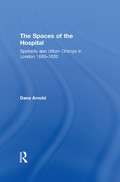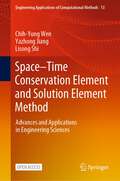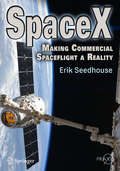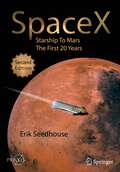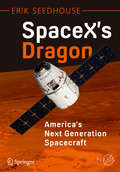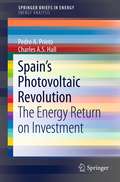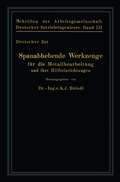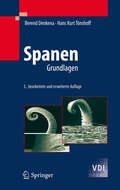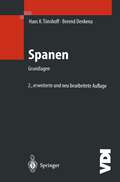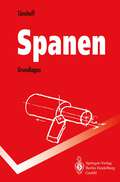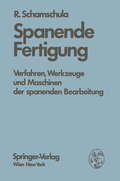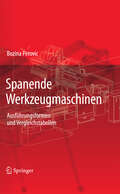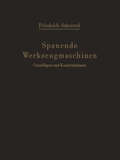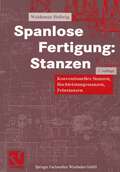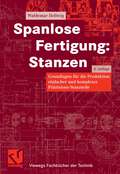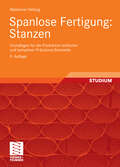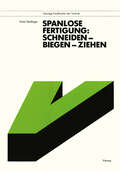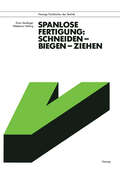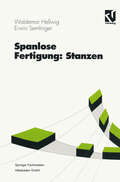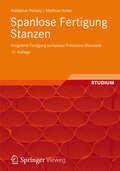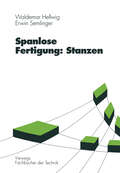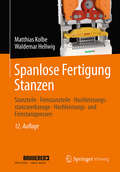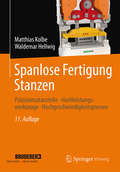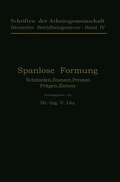- Table View
- List View
The Spaces of the Hospital: Spatiality and Urban Change in London 1680-1820
by Dana ArnoldThe Spaces of the Hospital examines how hospitals operated as a complex category of social, urban and architectural space in London from 1680 to 1820. This period witnessed the transformation of the city into a modern metropolis. The hospital was very much part of this process and its spaces, both interior and exterior, help us to understand these changes in terms of spatiality and spatial practices. Exploring the hospital through a series of thematic case studies, Dana Arnold presents a theoretically refined reading of how these institutions both functioned as internal discrete locations and interacted with the metropolis. Examples range from the grand royal military hospital, those concerned with the destitute and the insane and the new cultural phenomenon of the voluntary hospital. This engaging book makes an important contribution to our understanding of urban space and of London, uniquely examining how different theoretical paradigms reveal parallel readings of these remarkable hospital buildings.
The Spaces of the Hospital: Spatiality and Urban Change in London 1680-1820
by Dana ArnoldThe Spaces of the Hospital examines how hospitals operated as a complex category of social, urban and architectural space in London from 1680 to 1820. This period witnessed the transformation of the city into a modern metropolis. The hospital was very much part of this process and its spaces, both interior and exterior, help us to understand these changes in terms of spatiality and spatial practices. Exploring the hospital through a series of thematic case studies, Dana Arnold presents a theoretically refined reading of how these institutions both functioned as internal discrete locations and interacted with the metropolis. Examples range from the grand royal military hospital, those concerned with the destitute and the insane and the new cultural phenomenon of the voluntary hospital. This engaging book makes an important contribution to our understanding of urban space and of London, uniquely examining how different theoretical paradigms reveal parallel readings of these remarkable hospital buildings.
Space–Time Conservation Element and Solution Element Method: Advances and Applications in Engineering Sciences (Engineering Applications of Computational Methods #13)
by Chih-Yung Wen Yazhong Jiang Lisong ShiThis open access book introduces the fundamentals of the space–time conservation element and solution element (CESE) method, which is a novel numerical approach for solving equations of physical conservation laws. It highlights the recent progress to establish various improved CESE schemes and its engineering applications. With attractive accuracy, efficiency, and robustness, the CESE method is particularly suitable for solving time-dependent nonlinear hyperbolic systems involving dynamical evolutions of waves and discontinuities. Therefore, it has been applied to a wide spectrum of problems, e.g., aerodynamics, aeroacoustics, magnetohydrodynamics, multi-material flows, and detonations. This book contains algorithm analysis, numerical examples, as well as demonstration codes. This book is intended for graduate students and researchers who are interested in the fields such as computational fluid dynamics (CFD), mechanical engineering, and numerical computation.
SpaceX: Making Commercial Spaceflight a Reality (Springer Praxis Books)
by Erik SeedhouseThis first account of commercial spaceflight’s most successful venture describes the extraordinary feats of engineering and human achievement that have placed SpaceX at the forefront of the launch industry and made it the most likely candidate for transporting humans to Mars. Since its inception in 2002, SpaceX has sought to change the space launch paradigm by developing a family of launch vehicles that will ultimately reduce the cost and increase the reliability of space access tenfold. Coupled with the newly emerging market for governmental, private, and commercial space transport, this new model will re-ignite humanity's efforts to explore and develop space. Formed in 2002 by Elon Musk, the founder of PayPal and the Zip2 Corporation, SpaceX has already developed two state-of-the-art new launch vehicles, established an impressive launch manifest, and been awarded COTS funding by NASA to demonstrate delivery and return of cargo to the ISS. This book describes how simplicity, low-cost, and reliability can go hand in hand, as promoted in the philosophy of SpaceX. It explains how, by eliminating the traditional layers of internal management and external sub-contractors and keeping the vast majority of manufacturing in house, SpaceX reduces its costs while accelerating decision making and delivery, controls quality, and ensures constant liaison between the design and manufacturing teams.
SpaceX: Starship to Mars – The First 20 Years (Springer Praxis Books)
by Erik SeedhouseLearn about commercial spaceflight’s most successful startup in this fully updated book, which follows the extraordinary feats of engineering and human achievement that have placed SpaceX at the forefront of the launch industry and positioned it as the most likely candidate for transporting humans to Mars. This second edition emphasizes SpaceX's much-hyped manned mission to the Red Planet. With a plethora of new material gathered from 2013 to the present, the text offers the most up-to-date portrait of the maverick band of scientists and engineers producing some of the most spectacular aviation triumphs of the 21st century. Topics covered in this book include: all CRS flights, the challenges of developing retro-propulsion, and the pathway towards realizing the Falcon Heavy and BFR. In addition, the chapters describe SpaceX’s emphasis on simplicity, low-cost, and reliability, and the methods the company employs to reduce its costs while speeding up decision-making and delivery. Detailing the Falcon 1, Falcon 9 and Falcon Heavy launch vehicles, the book shows how SpaceX is able to offer a full spectrum of light, medium, and heavy lift launch capabilities to its customers and how it is able to deliver spacecraft into any inclination and altitude, from low Earth orbit to geosynchronous orbit to planetary missions. This book is the perfect go-to guide on SpaceX for anybody working or interested in the commercial space arena.
SpaceX's Dragon: America's Next Generation Spacecraft (Springer Praxis Books)
by Erik SeedhouseDragon V2 is a futuristic vehicle that not only provides a means for NASA to transport its astronauts to the orbiting outpost but also advances SpaceX’s core objective of reusability. A direct descendant of Dragon, Dragon V2 can be retrieved, refurbished and re-launched. It is a spacecraft with the potential to completely revolutionize the economics of an industry where equipment costing hundreds of millions of dollars is routinely discarded after a single use. It was presented by SpaceX CEO Elon Musk in May 2014 as the spaceship that will carry NASA astronauts to the International Space Station as soon as 2016.SpaceX’s Dragon – America’s Next Generation Spacecraft describes the extraordinary feats of engineering and human achievement that have placed this revolutionary spacecraft at the forefront of the launch industry and positioned it as the precursor for ultimately transporting humans to Mars. It describes the design and development of Dragon, provides mission highlights of the first six Commercial Resupply Missions, and explains how Musk hopes to eventually colonize Mars.
Spain’s Photovoltaic Revolution: The Energy Return on Investment (SpringerBriefs in Energy)
by Pedro A. Prieto Charles A. HallThe Energy Return on Energy Invested (EROI or EROEI) is the amount of energy acquired from a particular energy source divided by the energy expended, or invested, in obtaining that energy. EROI is an essential and seemingly simple measure of the usable energy or “energy profit” from the exploitation of an energy source, but it is not so easy to determine all of the energy expenditures that should be included in the calculation. Because EROI values are generally low for renewable energy sources, differences in these estimates can lead to sharply divergent conclusions about the viability of these energy technologies. This book presents the first complete energy analysis of a large-scale, real-world deployment of photovoltaic (PV) collection systems representing 3.5 GW of installed, grid-connected solar plants in Spain. The analysis includes all of the factors that limit and adjust the real electricity output through one full-year cycle, and all of the fossil fuel inputs required to achieve these results. The authors’ comprehensive analysis of energy inputs, which assigns energy cost estimates to all financial expenditures, yields EROI values that are less than half of those claimed by other investigators and by the solar industry. Sensitivity analysis is used to test various assumptions in deriving these EROI estimates. The results imply that the EROI of current, large-scale PV systems may be too low to seamlessly support an energy and economic transition away from fossil fuels. Given the pervasiveness of fossil fuel subsidies in the modern economy, a key conclusion is that all components of the system that brings solar power to the consumer, from manufacturing to product maintenance and life cycle, must be improved in terms of energy efficiency. The materials science of solar conversion efficiency is only one such component. Sunny Spain represented an ideal case study as the country had the highest penetration of solar PV energy at 2.3 percent of total national demand as well as state-of-the-art expertise in solar power including grid management of intermittent, modern renewable systems. This book, written by a uniquely qualified author team consisting of the chief engineer for several major photovoltaic projects in Spain and the world’s leading expert on the concept and application of EROI, provides a comprehensive understanding of the net energy available to society from energy sources in general and from functioning PV installations under real-world conditions in particular. The authors provide critical insight into the capacity of renewable energy sources to fill the foreseeable gap between world energy demand and depletion rates for fossil fuels.· Presents the first comprehensive study of the EROI of large-scale solar PV systems in a developed country· Uses real-world operational data rather than laboratory approximations and extrapolations· Describes the dependence of one alternative energy source on the goods and services of a fossil-fueled economy · Has global implications for the potential of renewable energy sources to replace dwindling reserves of fossil fuels· Written with the first-hand knowledge of the chief, on-site engineer for many solar installations in Spain together with the leader in the development and application of the concept of EROI
Spanabhebende Werkzeuge für die Metallbearbeitung und ihre Hilfseinrichtungen (Schriften der Arbeitsgemeinschaft Deutscher Betriebsingenieure #3)
by R. Bussein A. Cochius K. Güldenstein E. Herbst W. Hippler R. Koch H. Mauck J. Reindl O. Schmitz E. Simon E. TossaintDieser Buchtitel ist Teil des Digitalisierungsprojekts Springer Book Archives mit Publikationen, die seit den Anfängen des Verlags von 1842 erschienen sind. Der Verlag stellt mit diesem Archiv Quellen für die historische wie auch die disziplingeschichtliche Forschung zur Verfügung, die jeweils im historischen Kontext betrachtet werden müssen. Dieser Titel erschien in der Zeit vor 1945 und wird daher in seiner zeittypischen politisch-ideologischen Ausrichtung vom Verlag nicht beworben.
Spanen: Grundlagen (VDI-Buch)
by Berend Denkena Hans Kurt ToenshoffIn dem Band werden die physikalischen Grundlagen des Spanens unter Berücksichtigung neuester Forschungserkenntnisse dargestellt. Damit verknüpft stellen die Autoren wichtige Anwendungen wie z. B. Hochgeschwindigkeits- und Hochleistungsspanen vor. Sie vermitteln in dem Band die Anforderungen, denen moderne Werkzeuge und Werkzeugmaschinen sowie innovative Planungen spanender Prozesse genügen müssen. Die Möglichkeiten der Modellierung und Simulation werden in der 3. Auflage in einem neuen Kapitel erläutert. Mit Beispielaufgaben und Lösungen.
Spanen: Grundlagen (Springer-Lehrbuch)
by Hans K. TönshoffDieses einführende Lehrbuch über eines der zentralen Themen im Studium Maschinenbau behandelt Spanbildung, Spanformung, Kräfte beim Spanen, Energieumsetzung, Verschleiß, Schneidstoffe, Schleifen, Oberflächeneigenschaften und Kühlschmierung. Der Autor hat langjährige Erfahrung in der Lehre und gilt als einer der renommiertesten Fachleute in Deutschland. Diese Kombination verbindet sich in diesem Buch ideal, so daß das Werk für Studierende ebenso nützlich ist wie für den Ingenieur in der Praxis, der seine Kenntnisse auffrischen will.
Spanende Werkzeugmaschinen: Ausführungsformen und Vergleichstabellen
by Bozina PerovicDas Buch stellt aktuell auf dem Markt erhältliche Werkzeugmaschinen vor. Die Maschinen sind in Zeichnungen perspektivisch dargestellt, die Bauteile sind positioniert, die Funktionen beschrieben. Dargestellt sind auch spezielle Maschinen wie z. B. Entgratmaschinen, Trennschleifmaschinen und Transferstraßen. Die Maschinen werden anhand charakteristischer Merkmale wie Einsatzgebiet, Grundaufbau, Anzahl der Werkzeug- und Werkstückachsen, Ausstattung und technische Daten beschrieben und können auf einen Blick miteinander verglichen werden.
Spanende Werkzeugmaschinen: Grundlagen und Konstruktionen Ein Lehrbuch für Hochschulen, Ingenieurschulen und für die Praxis
by Friedrich SchwerdSpanlose Fertigung: Konventionelles Stanzen, Hochleistungsstanzen, Feinstanzen (Viewegs Fachbücher der Technik)
by Waldemar HellwigDas vorliegende Buch behandelt praxisorientiert die konventionelle Stanztechnik, die Hochleistungsstanztechnik und die Feinstanztechnik. Die Berechnungs- und Konstruktionsgrundlagen für das Schneiden, Biegen und Ziehen werden einzeln erklärt. Daneben gibt es zahlreiche Hinweise für die Konstruktion von Werkzeugen und für die Auswahl von Pressen, da das Werkzeug mit der Presse als Fertigungseinheit gesehen werden muss. Diese erweiterte Auflage enthält den aktuellen Stand der Normen und Richtlinien speziell für die Stanztechnik und erleichtert somit die Auswahl weiterer Unterlagen für die Praxis.
Spanlose Fertigung: Grundlagen für die Produktion einfacher und komplexer Präzisions-Stanzteile (Viewegs Fachbücher der Technik)
by Waldemar HellwigDas vorliegende Lehr- und Fachbuch behandelt praxisorientiert die konventionelle Stanztechnik, die Hochleistungsstanztechnik und die Feinstanztechnik. Die Berechnungs- und Konstruktionsgrundlagen für das Schneiden, Biegen und Ziehen werden anschaulich erklärt. Daneben gibt es zahlreiche Hinweise für die Konstruktion von Werkzeugen und für die Auswahl von Pressen. In dieser 8. Auflage wurden notwendige inhaltliche Aktualisierungen vorgenommen, insbesondere bei der Automatisierung von Stanzprozessen.
Spanlose Fertigung: Grundlagen für die Produktion einfacher und komplexer Präzisions-Stanzteile
by Waldemar HellwigDas vorliegende Lehr- und Fachbuch behandelt praxisorientiert die konventionelle Stanztechnik, die Hochleistungsstanztechnik und die Feinstanztechnik. Die Berechnungs- und Konstruktionsgrundlagen für das Schneiden, Biegen und Ziehen werden detailliert erklärt. Daneben gibt es wertvolle Hinweise für die Konstruktion von Werkzeugen und die Auswahl von Pressen. In der aktuellen Auflage wurden Normen und Tabellenwerte aktualisiert.
Spanlose Fertigung: Stanzen (Viewegs Fachbücher der Technik)
by Waldemar HellwigDie spanlose Fertigung erlaubt bei geringem Werkstoff-Abfall große Mengen von Werkstücken aus Metall oder anderen Werkstoffen in kurzer Zeit zu produzieren und erlangt deshalb eine wachsende volkswirtschaftliche Bedeutung. Das Fertigungsver fahren, das sich für die Herstellung einer größeren Anzahl von gleichen Teilen (Werk stücken) aus Bändern, Blechen oder Stäben eignet, wird als Stanzen bezeichnet. Es ist in der Regel ein zusammengesetztes Verfahren, das die Teile (Stanzteile) in einer oder mehreren Arbeitsfolgen innerhalb einer Stanzmaschine spanlos herstellt. Es kann sich aus Trennen (Schneiden) und Umformen zusammensetzen, wobei zum Umformen das Biegen, Ziehen und Prägen gehören kann. Zusätzliche Verfahren, wie Fügen, Nieten, Gewindeschneiden, Schweißen und Laserschneiden, werden dazu ebenfalls einbezogen und erweitern somit die Formenvielfalt der Stanzteile. Stanzteile sind Werkstücke, zu deren Herstellung die genannten Verfahren des Tren nens, Umformens, Fügens usw. angewandt werden. Sie werden durch zweiteilige formgebende Werkzeuge erzeugt. Als Arbeitsmaschinen dazu werden mechanische oder hydraulische Pressen verwendet, die eine geradlinige Hubbewegung ausführen. Für die Fertigungsgenauigkeit der Stanzteile ist die Form- und Maßgenauigkeit des Werkzeuges und die Führungsgenauigkeit der Maschine in der Arbeitsebene maßge bend. Der Begriff Stanztechnik kann also mehrere Verfahren integrieren und entzieht sich ei ner Einordnung in die Fertigungsverfahren nach DIN 8580. Gleichwohl haben sich industriell spezialisierte Stanztechniken entwickelt, die man wie folgt einteilen kann: 1. Konventionelle Stanztechnik 2. Hochleistungs-Stanztechnik 3. Feinstanztechnik 4. Nibbel-und Laserschneidtechnik 5. Großteil-Stanztechnik Die konventionelle Stanztechnik produziert Stanzteile mit mittleren Toleranzanforde rungen bei mittleren Hubfrequenzen und benutzt noch vielfach Werkzeugstähle in den Werkzeugen. Die Maschinenrahmen sind oft als C-Rahmen ausgeführt.
Spanlose Fertigung Stanzen: Integrierte Fertigung komplexer Präzisions-Stanzteile
by Waldemar Hellwig Matthias KolbeDas vorliegende Lehr- und Fachbuch behandelt praxisorientiert die konventionelle Stanztechnik, die Hochleistungsstanztechnik und die Feinstanztechnik. Die Berechnungs- und Konstruktionsgrundlagen für das Schneiden, Biegen und Ziehen werden detailliert erklärt. Daneben gibt es wertvolle Hinweise für die Konstruktion von Werkzeugen und die Auswahl von Pressen.
Spanlose Fertigung: Stanzen (Viewegs Fachbücher der Technik)
by Waldemar Hellwig Erwin SemlingerIn der fünften Auflage wurde eine Anpassung des Textes an die gültige Normung vorgenommen. Den Einflußgrößen bei der Gestaltung und Konstruktion von Werkzeugen aus diesem Bereich wird besonderer Wert beigemessen. Die zahlreichen Beispiele zeigen die Grundlagen, die zur Werkzeugkonstruktion benötigt werden. Eingestreute Aufgaben und vollständig durchgerechnete Beispiele machen das Buch auch zum Selbststudium geeignet.
Spanlose Fertigung Stanzen: Stanzteile ‒ Feinstanzteile ‒ Hochleistungsstanzwerkzeuge ‒ Hochleistungs- und Feinstanzpressen (Viewegs Fachbücher Der Technik Ser.)
by Matthias Kolbe Waldemar HellwigIn diesem Lehr- und Fachbuch finden Sie den aktuellen Stand der Stanz- und Feinstanztechnik. Gestaltungsregeln und Kennwerte aus der Praxis geben Hilfestellung bei der Konstruktion von Werkzeugen. Die rechnerische Bestimmung der Einflussgrößen, werkstofftechnische Grundlagen und funktionale Zusammenhänge unterstützen bei der Auswahl von Maschinen. Durch die zahlreichen Berechnungsbeispiele und vollständigen Lösungswege eignet sich dieses Buch sehr gut für das Selbststudium. In der 12. Auflage wurden Aktualisierungen und Neugestaltungen bei verbesserter Übersichtlichkeit vorgenommen. Neue Entwicklungen bei den Vorschubapparaten an Hochleistungsstanzautomaten sowie grundsätzliche Hinweise und Beispiele für die Hard- und Software zur Steuerung von Stanzprozessen wurden einbezogen. Völlig neu ist ein Kapitel, das alternative Schneidverfahren zur Erzielung hoher Schnittflächenqualitäten darstellt und einen direkten Vergleich zwischen einhubigen Schneidverfahren gestattet.
Spanlose Fertigung Stanzen: Präzisionsstanzteile, Hochleistungswerkzeuge, Hochgeschwindigkeitspressen (Viewegs Fachbücher Der Technik Ser.)
by Matthias Kolbe Waldemar HellwigDas vorliegende Lehr- und Fachbuch behandelt praxisorientiert die konventionelle Stanztechnik, die Hochleistungsstanztechnik und die Feinstanztechnik. Die Berechnungs- und Konstruktionsgrundlagen für das Schneiden, Biegen und Ziehen werden detailliert erklärt. Daneben gibt es wertvolle Hinweise für die Konstruktion von Werkzeugen und die Auswahl von Pressen. Für die aktuelle Auflage wurden die Abschnitte Schmierstoffe und mechanische Servopressen der Feinstanztechnik erweitert sowie die Werkstoffe der Stanz- und Feinstanztechnik den neuen Trends angepasst und zwei neue Berechnungsbeispiele aufgenommen. Viele Abbildungen wurden aktualisiert und in der Aussagekraft verbessert.
Spanlose Formung: Schmieden, Stanzen, Pressen, Prägen, Ziehen (Schriften der Arbeitsgemeinschaft Deutscher Betriebsingenieure #4)
by V. LitzDieser Buchtitel ist Teil des Digitalisierungsprojekts Springer Book Archives mit Publikationen, die seit den Anfängen des Verlags von 1842 erschienen sind. Der Verlag stellt mit diesem Archiv Quellen für die historische wie auch die disziplingeschichtliche Forschung zur Verfügung, die jeweils im historischen Kontext betrachtet werden müssen. Dieser Titel erschien in der Zeit vor 1945 und wird daher in seiner zeittypischen politisch-ideologischen Ausrichtung vom Verlag nicht beworben.
